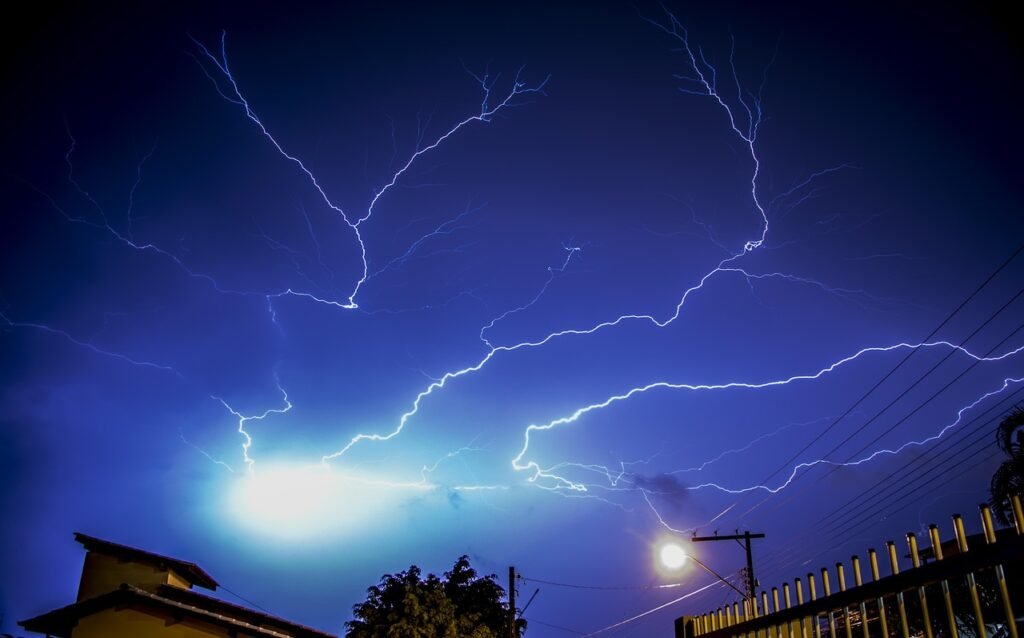Imagine lightning bolts so powerful they pierce through our atmosphere and reach toward the edge of space. These aren’t the typical flashes you see during thunderstorms, but something far more extraordinary. Picture electrical discharges that shoot upward from thunderclouds, traveling at incredible speeds to create towering pillars of light that can extend more than fifty miles above Earth’s surface.
You’re witnessing gigantic jets when turbulent conditions at towering thunderstorm tops allow lightning to escape the thunderstorm, propagating upwards toward space and rising 50 miles above thunderstorms. These magnificent phenomena represent nature’s most dramatic electrical displays, connecting our planet’s weather systems directly to the edge of space itself.
What Makes Lightning Strike Upward

Gigantic jets appear to initiate as an intracloud flash between the middle negative and upper positive charge regions in the thundercloud. Emerging research suggests they begin as a discharge between negative charge in the mid-levels of the cloud and the positive tops of clouds, leading to a negative “leader” of electricity that shoots upwards and escapes the cloud before it can actually discharge and “balance out” charge within the cloud.
This process is fundamentally different from ordinary lightning. There is usually a suppression of cloud-to-ground discharges with a buildup of negative charge, and conditions in the storm top weaken the uppermost charge layer, which is usually positive, so in the absence of the lightning discharges we normally see, the gigantic jet may relieve the buildup of excess negative charge in the cloud.
The Science Behind These Sky-High Bolts

The gigantic jet moved an estimated 300 coulombs of electrical charge into the ionosphere from the thunderstorm, while typical lightning bolts carry less than five coulombs between the cloud and ground or within clouds. Think of this as nature’s most powerful electrical conductor, capable of transferring energy on a scale that dwarfs regular lightning.
The upward discharge includes relatively cool streamers of plasma at approximately 400 degrees Fahrenheit, as well as structures called leaders that are very hot at more than 8,000 degrees Fahrenheit. These jets create an electrical bridge between the tops of the clouds at around 20 km and the upper atmosphere at around 100 km, making a direct electrical connection between the cloud top and the lower ionosphere.
Speed and Duration of Gigantic Jets

They begin as a cloud-to-air discharge that emanates out the top of thunderstorms, immediately growing to massive sizes up to 30 miles tall and shooting upwards at speeds of 6 to 90 miles per second, but only lasting two or three tenths of a second. Picture an electrical phenomenon that travels faster than anything you can imagine, yet exists for barely long enough to blink.
One jet was initially observed traveling up at around 50 km/s similar to typical lightning, increased to 160 and 270 km/s, then split in two and sped upward with speeds of at least 2,000 km/s. These extraordinary speeds showcase the raw power contained within these atmospheric giants.
The Brilliant Blue Glow

They mainly give off a blue light due to the high levels of nitrogen in the upper atmosphere, appearing bright blue almost like a neon sign since they are plasma after all, with the blue color believed to stem from “excited” nitrogen. The color is believed to be due to a set of blue and near-ultraviolet emission lines from neutral and ionized molecular nitrogen.
These jets often terminate with tendrils of branching red lightning, which can be faintly seen. This creates a spectacular visual display that combines the brilliant blue of the main discharge with delicate red tendrils spreading across the upper atmosphere.
How Scientists Study These Elusive Phenomena

The fact that the gigantic jet was detected by several systems, including the Lightning Mapping Array and two geostationary optical lightning instruments, was a unique event giving researchers more information on gigantic jets, probably the first time that a gigantic jet has been three-dimensionally mapped above the clouds. Researchers were able to map this gigantic jet in three dimensions with really high-quality data, seeing very high frequency sources above the cloud top with unprecedented detail and using satellite and radar data to learn where the very hot leader portion of the discharge was located above the cloud.
Gigantic jets were first discovered relatively recently, in 2002, so only a few dozen photographs of these massive bolts have ever been captured, though scientists think there could be up to 1,000 unseen jets every year. Most observations happen by pure chance when astronauts or aircraft passengers spot these remarkable displays.
The Connection to Other Sky Phenomena

Unlike gigantic jets which burst upward directly from thundercloud tops, sprites form independently much higher in the atmosphere following powerful lightning strikes, usually appearing as a reddish glow with intricate shapes resembling jellyfish, columns, or carrots and spanning tens of kilometers across, and may be accompanied by other TLEs such as Halos and ELVEs.
The two main types of jets are blue jets and gigantic jets, with blue starters considered to be a weaker form of blue jets that emanate upwards from cloud tops at speeds of about 100-140 km/s with a conical shape extending up to around 50 km in altitude, lasting 200 to 300 milliseconds. Gigantic jets reach higher altitudes than blue jets, terminating at 90 km, and while they may appear visually similar to carrot-type sprites, they differ in that they are not associated with cloud to ground lightning and propagate upward from the cloud at a slower rate.
Impact on Our Atmosphere and Technology

Experts suspect that upper atmosphere phenomena like blue jets may affect the concentrations of greenhouse gases in the atmosphere, since the ozone layer sits within the stratosphere where they occur. The large scale chemical impact of sprites, blue jets and blue starters and that of impulsive cloud corona discharges might be non-negligible in terms of their possibly measurable contribution to important greenhouse gases such as ozone and nitrous oxide, being the third strongest greenhouse gas after carbon dioxide and methane.
These flashes erupt in the same charged layers that carry radio waves and relay signals to submarines, and disturbing those layers can cause communications to fade or fail without warning, while for airlines, understanding when and where blue jets or gamma-ray flashes appear adds another layer of safety planning.
Conclusion: Nature’s Ultimate Light Show

Giant jet lightning has only been known about for the past 25 years, with the atmospheric jets associated with thunderstorms extending upwards towards Earth’s ionosphere, and the nature of gigantic jets and their possible association with other types of Transient Luminous Events such as blue jets and red sprites remaining active topics of research.
These towering electrical giants represent one of nature’s most spectacular and mysterious phenomena. From their origin in thunderclouds to their journey through the stratosphere, gigantic jets demonstrate the incredible power and beauty of atmospheric electricity. As technology advances and more observations become possible, we continue uncovering the secrets of these upward-striking bolts that literally reach for the stars.
What do you think about these incredible sky-high lightning displays? Have you ever witnessed something unusual during a thunderstorm that might have been one of these rare phenomena? Share your thoughts and experiences in the comments below.

Hi, I’m Andrew, and I come from India. Experienced content specialist with a passion for writing. My forte includes health and wellness, Travel, Animals, and Nature. A nature nomad, I am obsessed with mountains and love high-altitude trekking. I have been on several Himalayan treks in India including the Everest Base Camp in Nepal, a profound experience.




